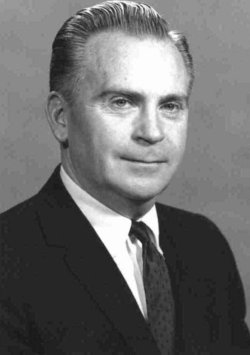Robert Kearns facts for kids
Quick facts for kids
Robert Kearns
|
|
|---|---|
 |
|
| Born |
Robert William Kearns
March 10, 1927 Gary, Indiana, U.S.
|
| Died | February 9, 2005 (aged 77) Baltimore, Maryland, U.S.
|
| Alma mater | University of Detroit Mercy (BSc) Wayne State University (MSc) Case Institute of Technology (PhD) |
| Occupation | Mechanical Engineer |
| Known for | Inventor of the intermittent windshield wiper |
Robert William Kearns (born March 10, 1927 – died February 9, 2005) was an American engineer and inventor. He is famous for inventing the intermittent windshield wiper system. This system is used on most cars today. It allows wipers to pause between wipes, which is very helpful in light rain or mist.
Kearns filed his first patent for this invention in 1964. He then tried to get big car companies like Ford, General Motors, and Chrysler to use his invention. They all said no at first. But then, starting in 1969, these companies began putting similar intermittent wipers in their cars.
This led Robert Kearns to take legal action. He won important patent infringement cases against Ford Motor Company and Chrysler Corporation. His fight to protect his invention was even turned into a movie called Flash of Genius in 2008. In the movie, actor Greg Kinnear played Robert Kearns.
Contents
Early Life and Studies
Robert Kearns served in the US Army during World War II. He was part of a group that was a early version of the CIA.
After the war, he went to college. He earned several degrees in engineering from different universities. These included the University of Detroit Mercy, Wayne State University, and Case Institute of Technology.
How the Wiper Idea Started
Kearns said he got the idea for his invention in 1963. He was driving his Ford car in a light rain. The regular wipers kept moving all the time, which bothered his eyes. He had an eye injury from his wedding night in 1953, which made his vision sensitive.
He thought about how the human eye blinks every few seconds, not all the time. He realized that car wipers could work the same way. They could pause between wipes, just like our eyes blink. This would make driving in light rain much easier and safer.
The Invention and Legal Battle
Kearns showed his new wiper idea to Ford. Ford liked the idea and wanted to use it in their cars. Kearns even started setting up factories to make his invention. But then, Ford stopped working with him.
In 1969, Ford started putting intermittent wipers in their cars. Kearns realized they were using his idea without his permission. He decided to sue Ford to protect his invention and patent. This legal battle lasted for many years. He even acted as his own lawyer in court.
Later, he also sued Chrysler for using his invention. He won both cases, proving that his invention was used without proper payment.
Family and Later Life
Robert Kearns and his family moved to Montgomery Village, Maryland in 1971. He worked for the National Institute of Standards and Technology, helping to create ways to measure how slippery roads were.
His long legal battles were very stressful for him and his family. He and his wife, Phyllis, separated. After winning his cases, Kearns moved to Maryland's Eastern Shore.
In his later years, he was involved with groups that supported veterans.
Legacy
Robert Kearns' story is a powerful example of an inventor fighting to protect his ideas. The 2008 movie Flash of Genius tells his amazing story.
Robert Kearns passed away on February 9, 2005, at the age of 77. He died from a combination of prostate and brain cancer, along with Alzheimer's disease. He left behind his children and grandchildren.
Patents
- [1] Windshield Wiper System with Intermittent Operation (Filed: December 1, 1964, Issued: November 1967)
- [2] Intermittent Windshield Wiper System (Filed: October 18, 1967, Issued: August 31, 1971)
- [3] Intermittent windshield wiper control system with improved motor speed (Filed: September 7, 1982, Issued: October 1, 1985)
- United States Patent 3,582,747 Intermittent windshield wiper system with electrodynamic braking (Filed: May 3, 1968, Issued: June 1, 1971)
- United States Patent 3,581,178 Windshield wiper control device (Filed: April 10, 1968, Issued: May 25, 1971)
- 22 other patents

